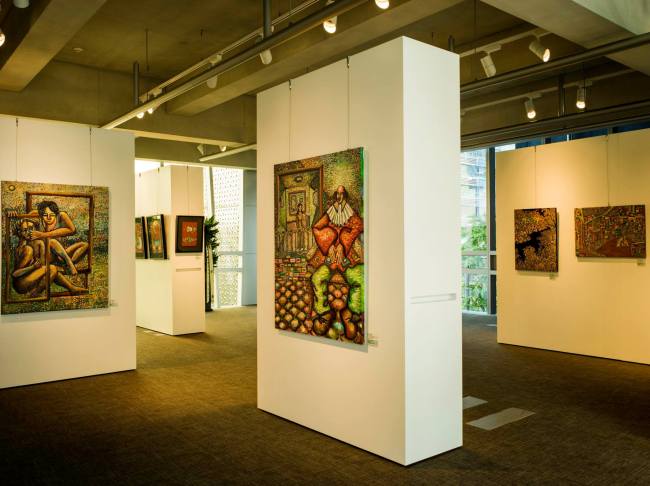[FUTURE OF FINANCE] Poultry firm discovers promising young artists with new financial program
By Korea HeraldPublished : Oct. 20, 2016 - 15:58
The newly built headquarters of Harim Group towers over the main entryway of Garosu-gil -- one of the most trendy streets in Seoul -- with thousands of light-emitting diode bulbs.
On the second floor of the 16-story building in Sinsa-dong, the works of young Korean artists are being exhibited at the Eco Rock Gallery run by Eco Capital, a financial unit of Harim.
On the second floor of the 16-story building in Sinsa-dong, the works of young Korean artists are being exhibited at the Eco Rock Gallery run by Eco Capital, a financial unit of Harim.

“We selected about 200 pieces of 20 young artists as of mid-October to put on sale with our installment financial program with no borrowing cost for 24 months,” said Jang Hyun-keun, CEO of Eco Capital.
“Along with the K-Shopping, K-Beauty, K-Pop and K-Food brands, we hope to start a K-Art brand introducing Korea’s promising artists to the world.” The event will go on throughout the Korea Sale Festa organized by the government.
The move is quite unusual, as Harim is the country’s No. 1 poultry and grain provider.
Harim’s Eco Capital, founded in 2010 originally for cattle firms, has been investing in cultural content funds. The company was one of the largest investors of the hit film “Train to Busan.”
Harim, indeed, has been making various attempts to step beyond their main businesses into the financial sector, driven by the government’s creative finance initiative.
One of them is to give young artists opportunities to display their works and link them with buyers through its installment financing program.
It was Jang’s idea to apply installment finance to arts as he believed there is a grey area in financing for the arts.
“Many young artists living in obscurity are in financial difficulties, and they get rare chances to display their works to the public,” he said. “On the buying side, Korean consumers aren’t yet familiar with the concept of arts shopping, since transparency is absent in the market with no secure financial means.”
In June, Jang asked for approval from the Financial Supervisory Service for the industry’s first installment financing program for arts.
In August, the financial watchdog approved the installment finance business for capital firms, exclusively for sales of the works of young artists.
“The FSS granted the approval based on the judgement that it can be a way toward creative finance,” Jang said. “Simply put, it’s the same as buying a vehicle on a 60-month installment.”
In Korean society, there is the stereotype that it usually costs a fortune to purchase a piece of art.
Eco Rock Gallery aims to change such perception by exhibiting affordable, yet original, unique and metaphoric works priced between 300,000 won ($266) to 3 million won.
“One important principle is we try to discover works embracing symbolic meanings and implicating something,” Jang said. “Good metaphors, strong colors and unique painting techniques that make viewers feel the artists’ passion are our main focus in discovering works.”
Since the gallery opened in September, the capital firm ran four exhibitions dubbed “The Beginning.” Over the past 1 1/2 months, some visitors who were just passing the building dropped by to check out the new place. A total of 38 works of young artists were sold through the Eco installment program, totaling 43 million won in sales.
During the Korea Sale Festa, the exhibition also drew Chinese tourists, who were initially simply visiting Garosu-gil.
“Our purpose is to introduce the works of young Korean artists to foreign tourists,” he said. “The gallery is located in the best place to do so.”
To attract attention from foreign investors, the gallery provides profiles of artists and details of their works in four languages, including Korean, English, Chinese and Japanese.
By Song Su-hyun (song@heralcorp.com)
-
Articles by Korea Herald










![[Hello India] Hyundai Motor vows to boost 'clean mobility' in India](http://res.heraldm.com/phpwas/restmb_idxmake.php?idx=644&simg=/content/image/2024/04/25/20240425050672_0.jpg&u=)









